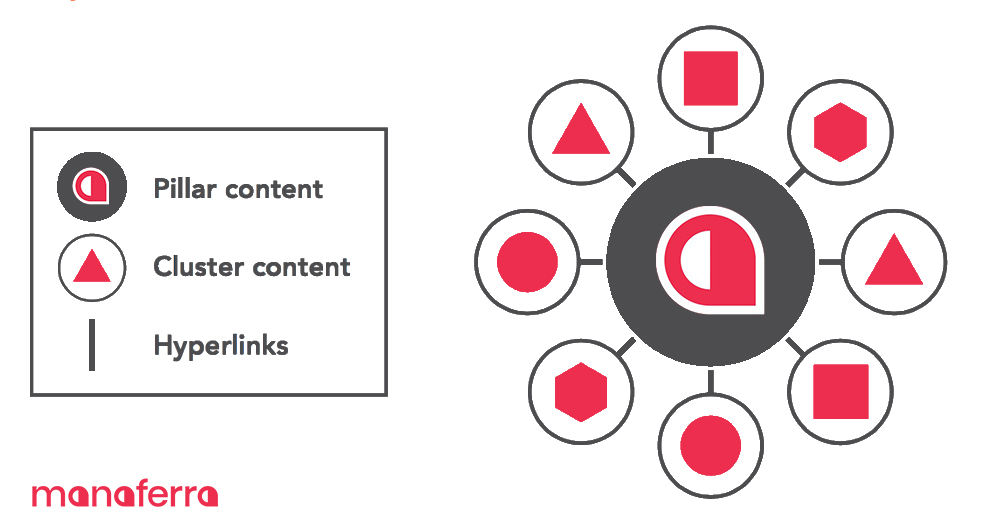

The topic cluster model is a content organizing model created and made popular by Hubspot. The content on their website inspired this model. Seeing that they were continually creating content, their website was starting to get crowded. Google was also beginning to favor topic-based content as opposed to keywords.
The Topic Cluster model uses a single page as the pillar, where all the clusters link to and from. It is organized with the topic model in mind to fit the algorithm and the need for simpler site architecture. That’s because most keywords have many long-tail variations, and creating a piece of content for each of them, without the topic cluster model, leaves us with crowded site architecture.
The topic cluster is built around a single page which is called the pillar page. The pillar page broadly covers a big topic and leaves room for the cluster pages to go in-depth with the subtopics. The pillar page is highly linkable, and all of the cluster pages link back to it. The pillar page links to its cluster pages as well. But not every cluster page is linkable in the pillar page, and that’s ok. Considering that the number of subtopic pages can be quite large, it is next to impossible to link all of them. Make sure that you only link to relevant subtopic pages that bring value to your visitors. User experience should not be compromised.
A resource pillar page is a page on your website that connects the reader with relevant subtopics to that particular topic. It has the format of a table of contents and is highly focused on internal and external links. The external links send people away from your website, but it creates the opportunity to generate inbound links from the sources mentioned on the page.
A 10x content pillar page goal is to provide a broad overview of a specific topic. This page is in the format of a guide and is usually a larger piece of content. Since not every piece of content you create cannot be a 10x content piece, these pages are to be considered your pillar pages.
A cluster page is an in-depth content piece that covers a topic briefly mentioned on the pillar page. The cluster page links to the pillar. By doing this, you funnel all of the traffic and value to the main topic page. This helps you distribute value to all of your pages and tells search engines that these pages (the pillar and clusters) are related during crawling.
Creating effective topic clusters requires that you find out the search volume on those particular topics, evaluate the content that already exists on your site and figure out what you need to write. You can collect and organize all this information in a Google sheet. Using templates like the one below can make your life easier. When you start creating topic clusters, you should have a few things in mind.

Keyword research is a key step to creating good topic clusters, given the fact that keyword search volume is one of the most important factors in what we write and what we don’t. Since the pillar content piece is based around a short-tail keyword, that particular keyword should have a high search volume. However, the cluster content page is created around a long-tail keyword, and thus that particular keyword has a smaller search volume.
Keyword research is a necessary step when creating new content with the topic cluster. However, when we look to organize existing content on our page to fit the topic cluster model, we need to evaluate all of it. Existing content can often clutter your site due to overlapping information, outdated keywords, or poor writing and editing. There are a few ways to improve the content on your site.
Deleting the Content Altogether is the right choice when the content is outdated, targets the wrong keywords, or is poorly written. This type of content, if kept, will not help you rank. On the contrary, it will prevent you from ranking higher due to keyword cannibalization and low-quality content.
Using 301 Redirect is a great way to remove outdated content while keeping link value from inbound links and redirecting the user to a relevant piece of content similar to the removed one.
Reviving Existing Content can be a great way to improve it if you’re already ranking quite high and have a good number of inbound links. You can do this by adding additional and updated information on that particular page. Stats, graphs, updated images, or videos will do the job. You can also update the Meta description and title tags and the date so you can let search engines and readers know that that piece of content has updated information.
Breaking up Long Content into Small Pieces helps if you don’t have anything new to say on that particular topic and the piece of content is quite large. This will leave you with more content than previously, and you’ll be able to target different keywords with them.
Only implementing the topic cluster model into your content strategy is not enough. There are a few things that you should think about when you do so. This model will work only when it’s done right.
Topic relevancy is the most important thing you should think about. If your pillar content page is not relevant to its cluster pages, it will fail to bring and keep the visitors interested.
Internal and external linking is the next step. If you have your pillar and cluster pages ready, the next step is to link them. Link your cluster pages to the right anchor text in your pillar page and vice versa. Don’t forget to add external links as well. Again, one might argue that that will send your visitors out of the site. That is true, but it will also make your content more valuable, trustworthy and might create the opportunity to generate inbound links from the sources mentioned on the page.
The benefits of topic cluster content are plenty. Your site will have a much clearer architecture, the number of internal links and their relevancy will increase, and it will definitely boost your search engine visibility. The pillar page should bring value to your site visitors. Only that way will you be able to attract interested visitors and receive leads, which is the main goal of the content.
The topic cluster model doesn’t always work. Actually, it might not be for most websites, and here’s why according to SiegeMedia.
The pillar page should broadly cover a certain topic. Often, websites will fail to identify a broad enough core topic that will act as the pillar. The topic you target should be a short-tail keyword, high in search volume, and high in competition. If the pillar page is based on a long-tail topic, you will not have a decent amount of subtopic pages to link it.
If you are trying to identify an existing pillar page or create a new one, make sure to do so correctly. Step back and see if the topic is broad enough. Will it give you the space to write a good number of articles around it.
There are times when the pillar content is too broad. This is when you try to rank for a too short of a tail keyword. Trying to rank for general search terms like “productivity” is not effective. Websites even go off-brand at times trying to rank for these terms.
Creating content on topics that are too similar can creates duplicate content. If the pillars you have chosen are too similar, your goal of ranking for that certain search term will fail to succeed. Your main discussion will be consumed by one pillar, leaving you with nothing to write and thus creating content that already exists.
The best way to understand the topic cluster model is through examples.

Typeform does pillar pages quite well. Their Brand Awareness page targets a broad enough topic, it’s relevant to their site, brings value to its visitors, and links to 28 other pages on their website.

This pillar page covers a more narrow topic but still broad enough to be considered a pillar page. What Matthew Barby has tastefully done here is that he has used CTAs to allow people to click on them so they can go to other pages on his website and learn about that particular tool. This pillar page also brings value to its visitors and is relevant to the content on his site.

Hubspot is really the best example of how to do a pillar page. Their Productivity Apps page has all the elements of a pillar page and has the potential to rank quite high. It targets a broad enough topic, and it’s relevant to Hubspot, brings value to its visitors, and links to seven other pages on their website.
The topic cluster model is a great way to adapt your site content to one that search engines favor. It will also help your site have a more clear site architecture. The topic cluster model benefits your site and your visitors at the same time. What’s important is that you do it correctly.

Ujëbardha Bekolli
Ujëbardha is a Jr. Outreach Specialist at Manaferra, skilled in content creation almost as much as link building. Although she graduated in Business Administration and Management, her digital marketing skills are really what catches the eye.
Ujëbardha is a Jr. Outreach Specialist at Manaferra, skilled in content creation almost as much as link building. Although she graduated in Business Administration and Management, her digital marketing skills are really what catches the eye.
Stay up to date with the latest marketing, sales, and service tips and news.